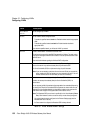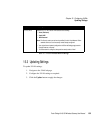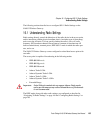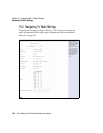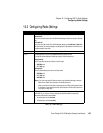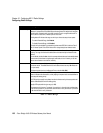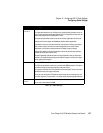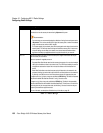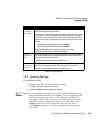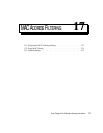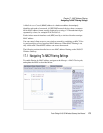
Chapter 16: Configuring 802.11 Radio Settings
Configuring Radio Settings
166
Psion Teklogix 9160 G2 Wireless Gateway User Manual
Extended Range
Atheros Extended Range (XR) is a proprietary method for implementing low rate traffic over longer
distances. It is transparent to XR enabled clients and access points and is designed to be interopera-
ble with the 802.11 standard in 802.11g and 802.11a modes. There is no support for Atheros XR in
802.11b, Atheros Turbo 5 GHz, or Atheros Dynamic Turbo 5 GHz.
Enabling Atheros XR will extend the range over which your client and access point can operate.
• To enable Extended Range, click Enabled.
• To disable Extended Range, click Disabled.
This option will not be available if you selected the hardware mode IEEE 802.11b, Atheros Turbo 5
GHz, or Atheros Dynamic Turbo 5 GHz. Atheros XR is not supported by these hardware modes.
Channel
The
Channel
defines the portion of the radio spectrum that the radio uses for transmitting and
receiving. The range of channels and the default channel are determined by the Mode of the radio
interface.
For most Modes, the default is
Auto
. Auto is the recommended mode because it automatically detects
the best channel choices based on signal strength, traffic loads, and so on. However, you can also
select a channel between one and eleven, inclusively.
Beacon Interval
Beacon
frames are transmitted by an access point at regular intervals to announce the existence of
the wireless network. The default behaviour is to send a beacon frame once every
100
milliseconds
(or 10 per second).
The Beacon Interval value is set in milliseconds. Enter a value from
20
to
2000
.
DTIM Period
The Delivery Traffic Information Map (
DTIM
) message is an element included in some
Beacon
frames. It indicates which client stations, currently sleeping in low-power mode, have data buffered on
the access point awaiting pick-up.
The DTIM period you specify here indicates how often the clients served by this access point should
check for buffered data still on the AP awaiting pickup.
Specify a DTIM period within the given range (
1 - 255
).
The measurement is in beacons. For example, if you set this to
1
, clients will check for buffered data
on the AP at every beacon. If you set this to
2
, clients will check on every other beacon. If you set this
to
10
, clients will check on every 10th beacon.
Field Description
Table 16.1 Radio Settings



